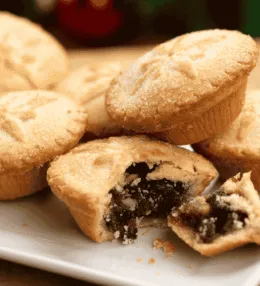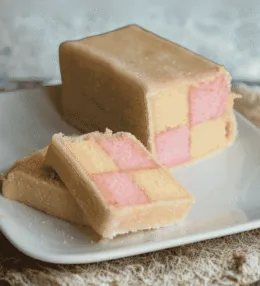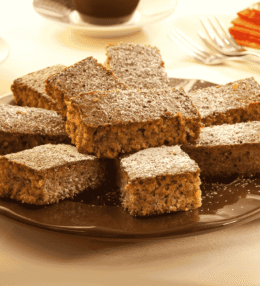
- View
Table of Contents
ToggleHelva is a Turkish dessert that epitomizes comfort, tradition, and a touch of indulgence. Made primarily from semolina, butter, and sugar, it transforms these simple ingredients into a creamy, fragrant dessert that’s both satisfying and memorable.
Helva is often prepared for special occasions, family gatherings, and ceremonies, embodying a sense of warmth and connection. Its smooth, slightly grainy texture and nutty flavour have made it a beloved dessert across Turkey and beyond.
Want to dive deeper into Turkish Cuisine? Don’t miss our post on 44 Traditional Turkish Foods to Try
What Is Helva?
Helva is a classic Turkish dessert made by toasting semolina in butter until it reaches a golden, aromatic stage, then blending it with sugar and milk to create a soft, pudding like texture.
It’s often garnished with pine nuts or almonds, which add a bit of crunch and a subtle, earthy flavour that complements the rich taste of the semolina. Helva is typically served warm, though it’s just as delicious at room temperature, making it a versatile dessert for any season.
In Turkish culture, Helva is more than just a sweet treat, it’s a dessert with deep rooted significance. It’s often prepared in moments of celebration, like weddings or the birth of a child, but also serves as a comforting dish in times of mourning, symbolizing remembrance and togetherness.
Ingredients and Taste
The ingredients in Helva are few but essential, each contributing to the dessert’s characteristic taste and texture. Semolina flour forms the base of the dish, giving it a distinct, slightly grainy texture that holds the flavours beautifully.
Butter is crucial for both its richness and its role in toasting the semolina, which releases a nutty aroma that defines the essence of Helva. Sugar and milk (or sometimes water) are added to sweeten and bind the mixture, transforming it into a soft, melt in the mouth dessert.
In terms of flavour, Helva strikes a delicate balance between sweet and nutty, with a hint of caramelization from the toasted semolina. The buttery richness and subtle sweetness make each bite comforting yet complex, with a smooth, slightly dense consistency that’s incredibly satisfying.
Often, Helva is garnished with toasted pine nuts or almonds, which add an extra layer of flavour and texture, enhancing the overall experience. The simplicity of the ingredients allows each one to shine, creating a dessert that’s as wholesome as it is indulgent.
A Taste of History
Helva has a long and storied history in Turkey and the surrounding region, with its roots stretching back to ancient times.
Originating from the Arabic word “halwa,” meaning “sweet,” Helva was introduced to Turkish cuisine through cultural exchanges across the Middle East and Central Asia. Over centuries, it evolved and adapted to local tastes, becoming a staple dessert in Turkish households.
In Turkish culture, Helva is more than a dessert, it’s a dish that carries symbolic meaning. Traditionally, Helva is prepared to mark life’s significant moments, both joyful and solemn. It’s common to make Helva for celebrations, such as weddings, where it symbolizes the sweetness of new beginnings.
Conversely, it is also prepared as a comfort food during times of mourning, often shared with family and friends as a way to honour the memory of a loved one. This dual role highlights the depth of meaning that Helva holds in Turkish society, where food often reflects life’s most meaningful experiences.

Turkish Helva (Sweet Semolina Dessert)
Equipment
- Small saucepan.
- Large, heavy bottomed pan.
- Stirring spoon.
- Serving bowls or moulds.
Ingredients
- 1 cup semolina
- 1/2 cup unsalted butter
- 1 cup granulated sugar
- 2 cups whole milk
- 1/4 cup pine nuts or slivered almonds optional, for added texture
- 1/4 tsp ground cinnamon for garnish, optional
Instructions
- Begin by preparing the milk mixture. In a small saucepan, combine the sugar and milk. Heat the mixture over medium heat until the sugar is fully dissolved, stirring occasionally. Once dissolved, set aside and keep warm, this will ensure a smooth consistency in the helva.
- In a large, heavy bottomed pan, melt the butter over medium heat. If you’re using pine nuts or almonds, add them to the butter once it melts and toast for about 2 minutes until golden and fragrant, taking care not to burn them.
- Add the semolina to the pan, stirring well to combine it with the butter. Keep stirring the semolina over medium-low heat for 10-15 minutes, or until it turns a golden brown colour. This toasting process enhances the flavour and gives the helva its characteristic nutty taste.
- Once the semolina has reached a golden hue, carefully pour the warm milk mixture into the pan, stirring continuously to avoid lumps. The mixture will bubble initially, so pour slowly to prevent splattering.
- Reduce the heat to low and continue stirring as the semolina absorbs the milk. The mixture will start to thicken and pull away from the sides of the pan. Stir until the mixture has a soft, creamy texture, and there’s no excess liquid remaining.
- Cover the pan with a lid, and let the helva sit for 5-10 minutes on low heat. This resting time helps the flavours meld and allows the dessert to reach the right consistency.
- After the resting period, fluff the helva with a fork to loosen it up. Taste and adjust for sweetness if desired by adding a bit of sugar or honey, stirring it in to incorporate evenly.
- To serve, spoon the helva into individual bowls or mould it using a small cup for a decorative shape. Garnish with a sprinkle of cinnamon or a few extra toasted pine nuts if desired. Serve warm for a comforting treat or at room temperature to allow the flavours to deepen.






